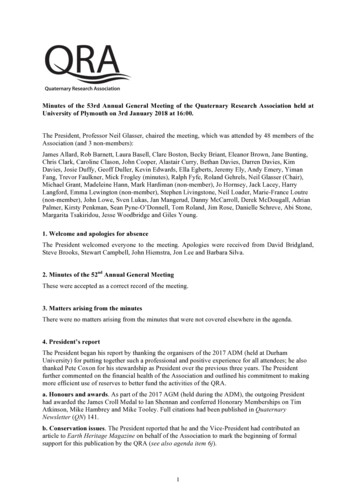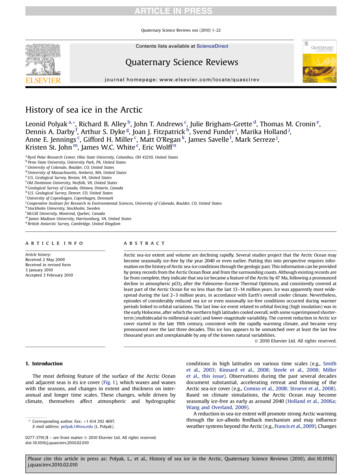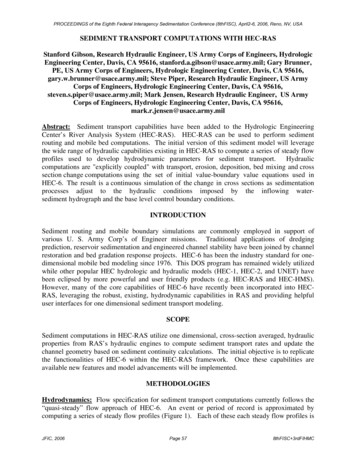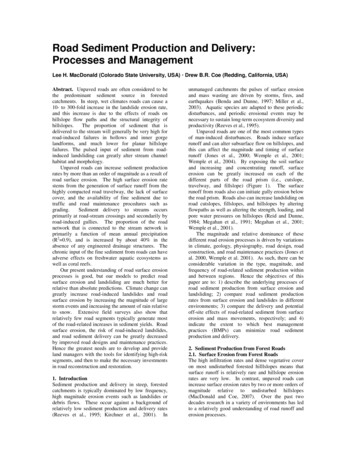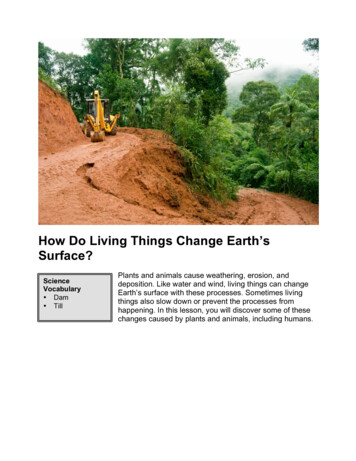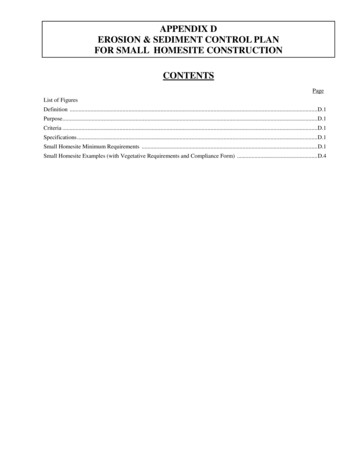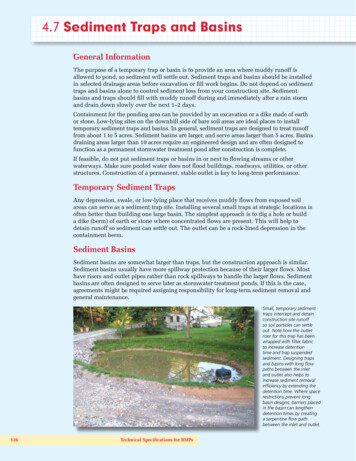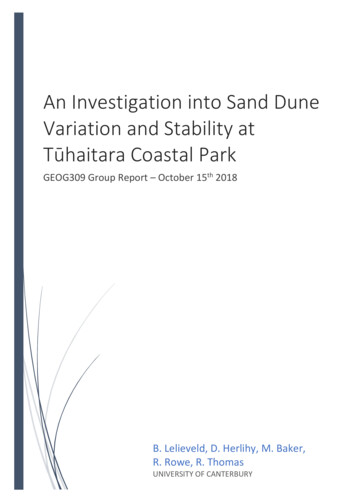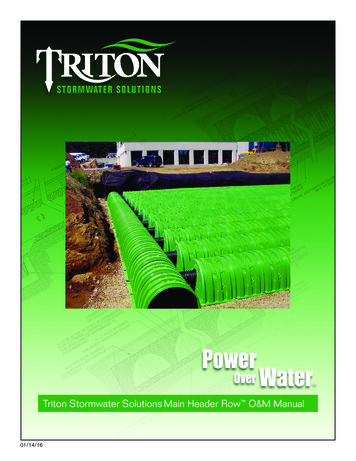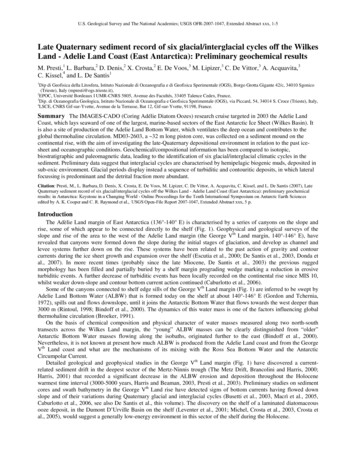
Transcription
U.S. Geological Survey and The National Academies; USGS OFR-2007-1047, Extended Abstract xxx, 1-5Late Quaternary sediment record of six glacial/interglacial cycles off the WilkesLand - Adelie Land Coast (East Antarctica): Preliminary geochemical resultsM. Presti,1 L. Barbara,2 D. Denis,2 X. Crosta,2 E. De Voos,3 M. Lipizer,3 C. De Vittor,3 A. Acquavita,34C. Kissel, and L. De Santis11Dip di Geofisica della Litosfera, Istituto Nazionale di Oceanografia e di Geofisica Sperimentale (OGS), Borgo Grotta Gigante 42/c, 34010 Sgonico(Trieste), Italy (mpresti@ogs.trieste.it),EPOC, Université Bordeaux I UMR-CNRS 5805, Avenue des Facultés, 33405 Talence Cedex, France,3Dip. di Oceanografia Geologica, Istituto Nazionale di Oceanografia e Geofisica Sperimentale (OGS), via Piccard, 54, 34014 S. Croce (Trieste), Italy,4LSCE, CNRS Gif-sur-Yvette, Avenue de la Terrasse, Bat 12, Gif-sur-Yvette, 91198, France.2Summary The IMAGES-CADO (Coring Adélie Diatom Oozes) research cruise targeted in 2003 the Adelie LandCoast, which lays seaward of one of the largest, marine-based sectors of the East Antarctic Ice Sheet (Wilkes Basin). Itis also a site of production of the Adelie Land Bottom Water, which ventilates the deep ocean and contributes to theglobal thermohaline circulation. MD03-2603, a 32 m long piston core, was collected on a sediment mound on thecontinental rise, with the aim of investigating the late-Quaternary depositional environment in relation to the past icesheet and oceanographic conditions. Geochemical/compositional information has been compared to isotopic,biostratigraphic and paleomagnetic data, leading to the identification of six glacial/interglacial climatic cycles in thesediment. Preliminary data suggest that interglacial cycles are characterised by hemipelagic biogenic muds, deposited insub-oxic environment. Glacial periods display instead a sequence of turbiditic and contouritic deposits, in which lateralfocussing is predominant and the detrital fraction more abundant.Citation: Presti, M., L. Barbara, D. Denis, X. Crosta, E. De Voos, M. Lipizer, C. De Vittor, A. Acquavita, C. Kissel, and L. De Santis (2007), LateQuaternary sediment record of six glacial/interglacial cycles off the Wilkes Land - Adelie Land Coast (East Antarctica): preliminary geochemicalresults: in Antarctica: Keystone in a Changing World - Online Proceedings for the Tenth International Symposium on Antarctc Earth Sciencesedited by A. K. Cooper and C. R. Raymond et al., USGS Open-File Report 2007-1047, Extended Abstract xxx, 5 p.IntroductionThe Adèlie Land margin of East Antarctica (136 -140 E) is characterised by a series of canyons on the slope andrise, some of which appear to be connected directly to the shelf (Fig. 1). Geophysical and geological surveys of theslope and rise of the area to the west of the Adelie Land margin (the George Vth Land margin, 140 -146 E), haverevealed that canyons were formed down the slope during the initial stages of glaciation, and develop as channel andlevee systems further down on the rise. These systems have been related to the past action of gravity and contourcurrents during the ice sheet growth and expansion over the shelf (Escutia et al., 2000; De Santis et al., 2003, Donda etal., 2007). In more recent times (probably since the late Miocene, De Santis et al., 2003) the previous ruggedmorphology has been filled and partially buried by a shelf margin prograding wedge marking a reduction in erosiveturbiditic events. A further decrease of turbiditic events has been locally recorded on the continental rise since MIS 10,whilst weaker down-slope and contour bottom current action continued (Caburlotto et al., 2006).Some of the canyons connected to shelf edge sills of the George Vth Land margin (Fig. 1) are inferred to be swept byAdelie Land Bottom Water (ALBW) that is formed today on the shelf at about 140 -146 E (Gordon and Tchernia,1972), spills out and flows downslope, until it joins the Antarctic Bottom Water that flows towards the west deeper than3000 m (Rintoul, 1998; Bindoff et al., 2000). The dynamics of this water mass is one of the factors influencing globalthermohaline circulation (Broeker, 1991).On the basis of chemical composition and physical character of water masses measured along two north-southtransects across the Wilkes Land margin, the “young” ALBW masses can be clearly distinguished from “older”Antarctic Bottom Water masses flowing along the isobaths, originated further to the east (Bindoff et al., 2000).Nevertheless, it is not known at present how much ALBW is produced from the Adelie Land coast and from the GeorgeVth Land coast and what are the mechanisms of its mixing with the Ross Sea Bottom Water and the AntarcticCircumpolar Current.Detailed geological and geophysical studies in the George Vth Land margin (Fig. 1) have discovered a currentrelated sediment drift in the deepest sector of the Mertz-Ninnis trough (The Metz Drift, Brancolini and Harris, 2000;Harris, 2001) that recorded a significant decrease in the ALBW erosion and deposition throughout the Holocenewarmest time interval (3000-5000 years, Harris and Beaman, 2003, Presti et al., 2003). Preliminary studies on sedimentcores and swath bathymetry in the George Vth Land rise have detected signs of bottom currents having flowed downslope and of their variations during Quaternary glacial and interglacial cycles (Busetti et al., 2003, Macrì et al., 2005,Caburlotto et al., 2006, see also De Santis et al., this volume). The discovery on the shelf of a laminated diatomaceousooze deposit, in the Dumont D’Urville Basin on the shelf (Leventer et al., 2001; Michel, Crosta et al., 2003, Crosta etal., 2005), would suggest a generally low-energy environment in this sector of the shelf during the Holocene.
10th International Symposium on Antarctic Earth SciencesFigure 1. Bathymetry map (Mercator projection) of the Adelie and George Vth Land margins (From De Santis et al.,2003, modified). Red dots: location of MD03-2603 and of the other IMAGES-CADO 2003 cores. Thin black lines:location of some existing reflection seismic data. The Southern Boundary of the eastward flowing AntarcticCircumpolar Current (ACC) is also shown (from Bindoff et al., 2000). South of this boundary the current is westwardflowing (Polar Current). The present Antarctic subglacial topography corrected for isostatic uplift is shown in the smallinsert on the upper right (from Denton et al., 1991), in which areas presently above sea level are shaded.As for the adjacent George Vth Land sector, the slope and rise sediments may have recorded the flow of saline anddense waters that were produced in the deep inner shelf basins (Adelie Deep), spilled out over the shelf edge and floweddown slope before flowing westward (Bindoff et al., 2000). The study of the sediment record of the Adelie Land andGeorge Vth Land margins is therefore crucial in understanding the contribution of Antarctic waters to the SouthernOcean circulation during past glacial and during interglacial periods warmer than present.This work presents preliminary geochemical and diatom analyses of core MD03-2603, collected during the
Presti et al.: Late Quaternary sediment record of six glacial/interglacial cycles off the Wilkes Land - Adelie Land Coast (East Antarctica): preliminarygeochemical resultsIMAGES-CADO (Coring Adélie Diatom Oozes) research cruise on the continental rise of the Adelie Land margin(Michel, Crosta et al., 2003). These results are compared and integrated with those of other stratigraphic records fromthe area in order to provide new understanding about Quaternary environmental conditions.Further coordinated multidisciplinary investigations of this margin are planned in the frame of the InternationalPolar Year, and include multiannual oceanographic measurements of bottom currents and sedimentological andbiological sampling to define the present and recent past environmental conditions and ecosystems.Materials and methodsCore MD03-2603 is 32 m long and was recovered in about 3200 m water depth on the continental margin off theAdelie Land during the MD130 Images-CADO cruise in 2003. Magnetic susceptibility and reflectance were measuredon board immediately after core recovery, splitting and description. δ15N and Norg content have been determined on 380samples, 20 samples have been analysed for their 232Th and 238U contents, and 40 samples have been analysed fordiatom biostratigraphy control at EPOC- University of Bordeaux I. Paleomagnetic data have been collected at the LSCEin Gif sur Yvette. Geochemical analyses (major and minor elements) have been performed on 400 samples at the OGSin Trieste analysing the digested samples by ICP-AES at Chelab (chemical labs, Treviso).ResultsFrom visual description the core appears homogeneous in the upper 9 m, with sparse pebbles and traces ofbioturbation. From 9 to 19 m depth there are sparse laminae and few erosive surfaces, whereas at depths from 19 mto the bottom of the core laminations and beddings are more common. The reflectance shows higher values in the top 9meters than in the section below (Fig. 2). High magnetic susceptibility values are often considered to represent abundantdetrital fraction and an IRD (Ice-Rafted Debris) component. Higher magnetic susceptibility peaks occur deeper than 15m down-core.Figure 2. Down-core profile of Reflectance and Magnetic Susceptibility in core MD03-2603 in relation to 230 Th-excessage control (diatom biostratigraphy control not shown here). The core appears to record at least 6 glacial/interglacialcycles.The average sedimentation rate based on 230Th excess has been estimated as 7.7 cm/kyr and is considered reliableup to MIS 6, that is down to 13 m depth (Fig. 2). The δ15N content varies between 2.9‰ and 6‰ down-core, with3
10th International Symposium on Antarctic Earth Scienceshigher average values in the upper 5 m (data not reported here). The Norg content varies between 0.05% at the core topto 0.02% at about 19 m (data not shown). The content and ratios of major and minor elements are very variable, withhigher abundances of Al, Fe and Ti associated with laminated intervals and higher ratios of Mn and Cu, Ni, Zn (towardsAl or Ti) towards the core top (data not shown).A preliminary stratigraphy has been defined by using the 230Th-excess, diatom biomarkers and the reflectancevariations (Fig. 2). Identified diatoms (data not shown here) include specific biomarkers such as Rouxia leventerae,Rouxia constricta and Hemidiscus karstenii and support the Thorium stratigraphy. The reflectivity variation itselfappears to match glacial and interglacial stages, together with the magnetic susceptibility. Several subunits in eachglacial stages (younger than MIS 6) have been identified: dark, coarse-grained, detrital-rich sub-units lay aboveerosional surfaces and are followed by finer-grained, laminated sub-units, grading upward into less dark, biogenic-richsub-units.A characteristic of this margin is the continuous sediment supply during both glacial and interglacial periods. Themagnetic susceptibility data show that glacial intervals are characterised by peaks in susceptibility which in some casescorrespond to turbidites (e.g. in MIS 8, 10 and 12 intervals, Fig. 2). These are consistent with the beginning of a glacialstage, when the ice-sheet advance toward the shelf edge, and was likely accompanied by frequent episodes of slopeinstability and turbidity currents. Present day interglacial bottom turbidity is demonstrated by nepheloid layers (Eittreimet al., 1971).In distal sites like the one of core MD03-2603 turbidites, probably interbedded with entrained hemipelagic biogenicmaterial, were redeposited as sediment drift by contour currents, during the glacial and interglacial times. The MD032603 record represents therefore a good archive for investigating the dynamics of depositional processes related to bothdownslope and alongslope bottom currents. These contour currents are linked in this sector of the Antarctic margin tothe flow and strength of the Antarctic Bottom Water mass and therefore their deposits are potentially a long-term recordof AABW variations.Since the role of lateral sediment focussing has to be clearly evaluated in order to better characterise the “primaryproductivity” information provided by δ15N and Norg, a comparison with compositional elemental data (major and minorelements and their ratio to Al or Ti – linked to the detrital component) has proved to be very useful.Acknowledgements. The authors wish to acknowledge the co-editor, Prof. J Anderson, for improving the text and for discussion, and Prof. A.Cooper for editing advices. Thanks to all the crew of the R.V. Marion Dufresne for their help and to several people who helped in various stages ofthe projects. The authors wish to acknowledge the support of the EU Marie-Curie Reintegration Grant “HOLOSED” (M. Presti) and PNRA/MOGAMproject (L. De Santis).ReferencesBindoff, N.L., Rosenberg, M.A. and Warner, M.J., 2000. On the circulation and water masses over the Antarctic continental slope and rise between 80and 150 E. Deep-Sea Research II, 47: 2299-2326.Broecker, W. S., 1991. The great ocean conveyor. Oceanography, 4: 79-89.Busetti, M., Caburlotto A., Armand L., Damiani D., Giorgetti G., Lucchi R.G., Quilty P.G., Villa G., 2003. Plio-Quaternary sedimentation on theWilkes land continental rise: preliminary results. Deep Sea Research Part II, Volume 50, Number 8: 1529-1562.Bindoff, N.L., M.A. Rosenberg,and M.J. Warner (2000). On the circulation and water masses over the Antarctic continental slope and rise between 80 and 150 E. Deep-SeaResearch II 47, 2299-2326.Brancolini, G. and P. Harris (2000), Post Cruise Report AGSO Survey 217: Joint Italian/Australian Marine Geoscience Expedition Aboard the R.V.Tangaroa to the George Vth Land Region of East Antarctica during February-March, 2000. AGSO Record 2000/38, 180 ppCaburlotto, A., L. De Santis, A. Camerlenghi, J.K. Dix, and C Zanolla (2006) ,New insights into Quaternary Glacial Dynamic Changes on TheGeorge Vth Land Continental Margin (East Antarctica). Quaternary Science Reviews, 25, 3029-3049.Crosta, X., Crespin, J., Billy, I. and Ther, O., 2005. Major factors controlling Holocene δ13Corg changes in a seasonal sea ice environment, AdélieLand, East Antarctica. Global Biogeochemical Cycles, 19 (4): GB402910.1029/2004GB002426Denton, G. H., M. L. Prentice and L. H Burle, 1991. Cainozoic history of the Antarctic Ice Sheet. In: Tingey, R. J. (Ed.), The Geology of Antartica.Clarendon Press, Oxford, pp. 365-433.De Santis, L., G. Brancolini, and F. Donda, (2003). Seismo-stratigraphic analysis of the Wilkes Land continental margin (East Antartica): influence ofglacially driver processes on the Cenozoic deposition. Deep-Sea Research II 50 (8-9), 1563-1594.De Santis L., G. Brancolini, D. Accettella, A. Cova, A. Caburlotto, F. Donda, C. Pelos, F. Zgur, M. Presti (2007), New insights into submarinegeomorphology and depositional processes along the George V Land continental slope and upper rise (East Antarctica)– Online Proceedings of the10th ISAES X, edited by A. K. Cooper and C. R. Raymond et al., USGS Open-File Report 2007, Extended Abstract.Donda F., G. Brancolini, P. E. O’Brien, L. De Santis., and C. Escutia (2007), Sedimentary processes in the Wilkes Land margin: a record of theCenozoic East Antarctic Ice Sheet evolution. Journal of the Geological Society, London, Vol. 164, pp. 243–256Eittreim, S.L., A.L. Gordon, M. Ewing, E.M. Thorndike, and P.M. Bruchhausen (1971), The nepheloid layer and observed bottom currents in theIndian-Pacific Antarctic Sea. In: Studies in Physical Oceanography-A tribute to George Wust on his 80th birthday. Gordon and Breach, New York,pp. 19-35.Escutia, C., S.L. Eittreim, A.K. Cooper, and C.H. Nelson (2000), Morphology and acoustic character of the Antarctic Wilkes Land turbidite system:Ice-sheet sourced versus river-sourced fans. Journal of Sedimentary Research 70 (1), 84-93.Gordon, A.L., Tchernia, P., 1972. Waters of the continental margin of the Adelie Coast, Antarctica. In: Antarctic Oceanology II: The Australian-NewZealand Sector. Antarctic Research Series 19, 59-70.Harris P.T., Brancolini G., Armand L., Busetti M., Beaman R.J., Giorgetti G., Presti M., Trincardi F., 2001 . Continental shelf drift deposit indicatesnonsteady state Antarctic bottom water production in the Holocene. Marine Geology, 179, pp. 1-8.Harris, P. and R. Beaman, (2003) Processes controlling the formation of the Mertz Drift, George Vth continental shelf, East Antarctica: evidence from4
Presti et al.: Late Quaternary sediment record of six glacial/interglacial cycles off the Wilkes Land - Adelie Land Coast (East Antarctica): preliminarygeochemical results3.5 kHz sub-bottom profiling and sediment cores. Deep-Sea Research II 50 (8-9), 1463-1480.Leventer, A., Brachfield S., Domack E., Dunbar R., Manley P. and McClennen C. (2001), Coring Holocene Antarctic ocean sediments—NBP0101Cruise Report.Macrì P., L. Sagnotti, J. Dinares-Turell, A. Caburlotto (2005), A composite record of Late Pleistocene relative geomagnetic paleointensity from theWilkes Land Basin (Antarctica), Physics of the Earth and Planetary Interiors 151, 223–242Michel E., Crosta X. and shipboard party, 2003. CADO: Coring Adélie Diatom Oozes. Cruise Report. Institut Polaire Francais Paul-Émile Victor(IPEV).Presti M., L. De Santis, M. Busetti, and P. T. Harris (2003), Late Pleistocene and Holocene sedimentation on the Gorge V Continental Shelf, EastAntarctica. Deep-Sea Research II 50 (8-9), 1441-1461.Rintoul, S.R., 1998. On the origin and influence of Adélie Land bottom water. In: S. Jacob (Editor), Ocea, Ice and Atmosphere: Interactions at theAntarctic Continental Margin. American Geophysical Union, Washington D.C., 151-171.5
Coast, which lays seaward of one of the largest, marine-based sectors of the East Antarctic Ice Sheet (Wilkes Basin). It is also a site of production of the Adelie Land Bottom Water, which ventilates the deep ocean and contributes to the global thermohaline circulation. MD03-2603, a 32 m long piston core, was collected on a sediment mound on the
